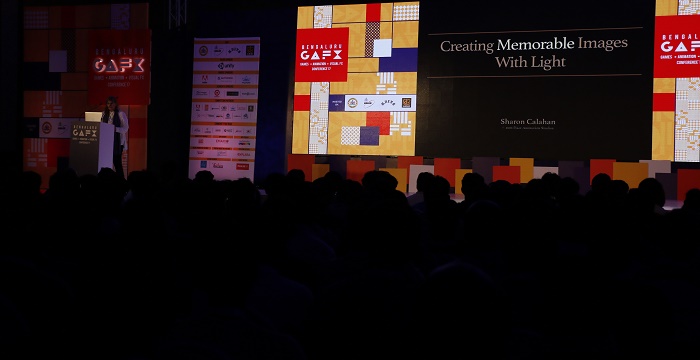Day one of Bengaluru GAFX kick started today and it was a day full of workshops. Bengaluru’s The Lalit Ashok’s Kalinga, Grand Ballroom and Lalit 1 and 2 halls were packed with students and professionals eager to soak-in all the knowledge being shared by the industry professionals.
Many were waiting for Sharon Calahan’s ‘Storytelling with Light’ session and as the doors opened, the entire Kalinga hall got filled within minutes. Calahan has been a part of Pixar Animation studio since more than two decades now and has served as director of photography on films like A Bug’s Life, Toy Story 2 and Finding Nemo. Her most recent work is on the movie The Good Dinosaur.
In today’s session she shed light on how to create beautiful and memorable images to enhance storytelling. Though she has never worked on a live-action movie, Calahan having studied in art school, likes taking live-action movie references while working on her projects. On blurring of the lines between animation and live action photography, she said that they always try to approach animated filmmaking by learning from earlier animated works and from the live action world.
Her session made us realise the importance of light while shooting a movie. The various perspectives and messages conveyed by just the position of light. So now the question arises how to go about creating such memorable images with light? There are four main criterias. Calahan says, “The light should be directing the eye, it should support story emotion, should maintain continuity and finally should add beauty to the overall composition of the frame.”

With the help of live-action feature film stills from movies like Hannibal, Tequila Sunrise, Se7en, Barfi, Road to Perdition, The Assassination of Jesse James, Charlie Wilson’s War, she explained the various roles light can play. She suggested that one should use light to isolate character from the others. Can use indirect light which helps in making the character feel strong. Round shapes have strong emotional attachment. Reflections help in showcasing two characters in one shot.
Usually animators are suggested to not use tangents, however as a cinematographer, she would love to use it in her movies. “Animators are taught one focal vision. I find multiple focal points more interesting. As long as the lights are positioned in the correct manner and leads the audience’s eye from the main subject to the next main objects, it shouldn’t be a problem.”
If the lighting artists feel that the overall design of the shot is not good, then Calahan suggests them to shrink the shot down to the size of a postcard and then asks them to tell what they can see. This helps them in knowing how the frame would look like on the big screen.
Black and white movies like Morituri help understand the various layers the light can help achieve. How light areas over dark areas and vice-versa look like and help establish characters or sequences.
Addressing the students, she said, “Most of the new joinees make everything dark in the movie. It is important to remember that each genre has a different style. One cannot have dark lighting in a family friendly movie. So, one should understand that same genre movies have same style of lighting which can be seen throughout the film.”
Though most of the elements which we see in live-action movies cannot be used in animated films, Calahan hopes to use them someday. As much as we would have loved to learn more about the role of light in movies, the clock ticked by and her session got over.
On 14 May, Sharon Calahan will be having another session on the work done on ‘The Good Dinosaur.’

